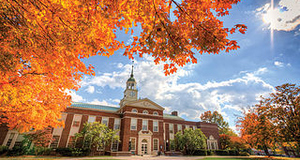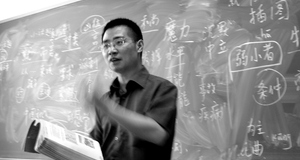"Responsiveness" in American Higher Education: The Evolution of Institutional Governance Structures
By
2016, Vol. 8 No. 02 | pg. 2/2 | « History of Curricular ResponsivenessCurricular changes in the American context were marked by deliberation and constant debate among educational leaders (Snow, 1907). This is not to say that systemic responsiveness is not met with opposition. However, given the relatively contemporary nature of systemic changes, curricular adjustments challenged more well established educational traditions. Preparing leaders with good Christian values became the driving force behind the construction of the college curriculum as a response to the external demands of prominent Protestant officials (Veysey, 1965). Accordingly, institutions developed mission, curriculum, and rules/regulations to integrate ministerial education into the Arts & Sciences framework (Brubacher, 1997). At the same time, college students were still seen as immature both physically and mentally. Prescribing a fixed curriculum was one prong of the attack; however the tenets of mental discipline also signify a response inside institutions to the views of the Colonial elite. To perpetuate prosperity and transfer traditions of European colleges, the colonial version would seek to ensure curriculum revered classic subjects such as logic, rhetoric and arithmetic (Lucas, 2006). European institutions at the time had an established cash of intellectual elite, and the American model would have to respond to demand for the same in the colonies. Colonial curricular responsiveness aimed to respect religious demands and traditional ideas of higher education, by preserving the “social contract” transplanted from Europe. While the students were the ultimate recipients of curricular responsiveness, in this case the “social contract” between colleges and society was a much deeper bond. Following the American Revolution, antebellum institutions began to question why mission and curriculum were based on European elitist traditions that had repulsed the founders of the new nation. As the nation expanded westward, the need for engineers, architects, surveyors, and farmers far outstretched the need for “good Christian leaders” (Veysey, 1965). When vocational demands from outside the walls of the college threatened to re-shape the traditional colonial curriculum, proponents of “mental discipline” came to its defense.The Yale Report of 1828 issued by Jeremiah Day defended the traditional curriculum, and its ability to refine the soul’s faculties and train the attention span (Lucas, 2006). Day invoked the power of universities to use responsiveness to protect not only current, but future interests of its primary stakeholders. Francis Wayland of Brown moved the needle in a positive direction, noting that responsiveness to vocational needs was necessary to begin expanding the borders of the new country (Snow, 1907). Curricular responsiveness increased when the channels between the interior of institutions and society began to open up, thereby increasing the strength of the “social contract” between institutions and the broader society. Curricular response at this time, invested in new institutional models, did not stop at vocational concerns. The “social contract” was extended to previously marginalized groups (i.e. woman/blacks) in order to establish new colleges that served their specific educational needs. Endeavors of this magnitude were needed in order to fill a void left by old institutions that were not so quick to respond. Woman were given the opportunity to exit their “natural sphere” at degree granting female institutions such as Mt. Holyoke and Bryn Mawr in the mid-19th century, and eventually were educated side by side with men beginning with the University of Iowa in 1855. These models illustrate curricular responsiveness by their ability to assess the ability of women to use education to bring positive changes to society. New models were also created to increase educational opportunities for blacks at the same time. Founders of black colleges during reconstruction initially responded by developing curricula that were to be equal to white institutions in quality and quantity (Lucas, 2006). The nature and purpose of black higher education would be highly disputed between appeasement/utility (Washington, 1903) and raising up a well-educated group of black leaders (Du Bois, 1903). It could be suggested that black institutions could be affixed into both curricular and system responsiveness. However, in most instances, Black institutions developed a curriculum specifically tuned to the needs of its students attempting to gain economic and social equality (Lucas, 2006). This type of responsiveness, although it enraged W.E.B. Du Bois, illustrates the way external demands will linked to internal changes at all levels of higher education. Contemporary colleges and universities in the United States have had to become exponentially focused on that very same group of stakeholders, in addition to new types of diversity. The movement toward “universal” access has dictated that students from different ethnic, social, and educational backgrounds be granted admittance to institutions of higher education (Trow, 2005). Tones, Fraser, Elder and White (2009) assessed the amount of services provided for adult Latino and Black students, illustrating an entirely new level of curricular responsiveness that builds from the systemic changes outlined above. Studies such as Rendon (2001) have contributed a significant amount of time to understanding what strategies would benefit minorities in an effort to decrease departure rates and increase persistence. As a result, colleges and universities have initiated programs that would be able to properly educate students on diversity by including it in required core curriculum (Gurin, 2002). The degree of focus therefore increases as stakeholders in higher education become increasingly diverse, resulting in a consumer driven curricular response (Green, 1973). Higher education institutions then respond by initiating classroom based diversity initiatives to meet the demand of new student populations. Another example of such curricular changes resides in the contemporary proliferation of adult students. As bachelors and master’s degree attainment becomes a more popular requirement for access to higher paying jobs, the demand to respond to these students needs increases. Special curricular services, such as hybrid and online courses have been developed to meet untraditional student demands (Plageman, 2011). Additional programs offered such as: accelerated or remedial classes, distance learning, and professional programs, also infuse the definition of curricular responsiveness that notes institutional innovation to meet student needs, and adhere to the “social contract.” ConclusionAssessing the scope of Johnstone’s claim that responsiveness is a hallmark characteristic of American higher education requires respect to its historical development, from colonial to contemporary periods. Incremental shifts in governance, mission, and curriculum significantly transformed the definition of responsiveness into something more complex. System responsiveness looked to reshaping the internal framework of higher education from the standpoint of governance, academic freedom and equality/quality. Curricular responsiveness invested in more student focused, modular changes dictated by religious, pedagogical and demographic shifts. These shifts increased in pace and intensity over time, eventually leading to curricular responses vested in developing new types of institutions such as Cornell, along with new methods of instruction promoting distance learning in contemporary settings. Systemic and curricular responsiveness respect a “social contract,” committed to the needs of diverse stakeholders inside and outside the institution of higher education. Expanding upon this history and looking toward the future of American higher education, the “responsiveness” that Johnstone (2003) emphasizes could have international implications. First, as international institutions of higher education begin progress, albeit slowly, toward “universal” access, the success of these models will have to respond to economic, industrial, and social needs to ensure quality and future success. Secondly, international colleges and universities will have to use the success of American higher education to respond as an exemplar for their own system and curricular consciousness. Finally, strong consideration must be given to implementing access programs as a response to historically based hierarchies that still persist through the existence of educational ministries. System and curricular considerations must work together in order to achieve this goal effectively. What Johnstone identified as a characteristic that distinguishes American higher education, may in fact eventually lead to more homogeneous versions of college and university responsiveness on the international level as paradigms continue to shift. Perhaps over time, international constituencies will become responsive to the features which have distinguished American higher education throughout its history. ReferencesApple, M (2001). Educating the right way. New York: Routledge. Arnold, C., & Franklin, M. N. (2012). Introduction: Issue congruence and political responsiveness.Western Politics,35(6), 1217-1225. doi: 10.1080/01402382.2012.713741 Benneworth, P., & Jongbloed, B. (2010). Who matters to universities? A stakeholder perspective on humanities, arts and social sciences valorisation.Higher Education,59(5), 567-588. doi: 10.1007/s10734-009-9265-2 Brubacher, J. S., & Rudy, W. (1997).Higher education in transition: A history of American colleges and universities. Transaction Pub. Butin, D. W. (2007). Focusing our aim: Strengthening faculty commitment to community engagement.Change,39(6), 34-39. Cheng, Y. C., & Tam, W. M. (1997). Multi-models of quality in education. Quality assurance in Education, 5(1), 22-31. Cohen, A. M. (2007).The shaping of American higher education: Emergence and growth of the contemporary system. Jossey-Bass. Conner, T. W., & Rabovsky, T. M. (2011). Accountability, affordability, access: A review of the recent trends in higher education policy research. Policy Studies Journal, 39, 93-112. doi: 10.1111/j.1541-0072.2010.00389_7.x Cowley, W. H. (1980).Presidents, professors, and trustees. Chicago: Jossey-Bass. Cullen, J. B., Long, M. C., & Reback, R. (2012). Jockeying for Position: Strategic High School Choice under Texas’ Top Ten Percent Plan.Journal of Public Economics. Dennison, G. M. (2010). Reform and re-invention in public higher education.Innovative Higher Education,35(2), 75-78. doi: 10.1007/s10755-009-9131-2. Dey, E. L., & Hurtado, S. (2005). College students in changing contexts. In P. G. Althbach, P. J. Gumport & R. O. Berdahl (Eds.), American higher education in the twenty-first century: Social, political and economic challenges (3rd ed., pp. 515-559). Baltimore: The Johns Hopkins University Press. Du Bois, W. E. B. (1903).The talented tenth(pp. 102-04). James Pott and Company. Eaton, J. S. (2006). An overview of US accreditation (Vol. 1). Washington: Council for Higher Education Accreditation. Edson, C. H. (1978). Curriculum change during the progressive era. Educational Leadership, 36(1), 64. Frankel, N., & Dye, N. S. (Eds.). (1994).Gender, class, race, and reform in the Progressive Era. University Press of Kentucky. Fuchs, R. F. (1963). Academic freedom--its basic philosophy, function, and history. Law & Contemp. Probs., 28, 431. Green, M. (1973). Consumerism in Higher Education.Journal of the National Association of College Admissions Counselors,18(1), 8-11. Gurin, P., Dey, E. L., Hurtado, S., & Gurin, G. (2002). Diversity and higher education: Theory and impact on educational outcomes. Harvard Educational Review, 72(3), 330. Johnstone, D. B. (2003). The international comparative study of higher education: Lessons from the contemplation of how others might see us.Forum for the Future of Higher Education. Kerr, C. (2001).The uses of the university. Boston: Harvard University Press. Kezar, A. J. (2004). Obtaining integrity? reviewing and examining the charter between higher education and society.Review of Higher Education,27(4), 429-459. Kaufman, R. A. (1968). A system approach to education: Derivation and definition. AV communication review, 16(4), 415-425. Lucas, C. J. (1996).American higher education: A history. Palgrave MacMillan. Metzger, W. P. (1969).Academic Freedom in the Age of the University(Vol. 12). Columbia University Press. Moses, M. S. (2001). Affirmative action and the creation of more favorable contexts of choice.American Educational Research Journal,38(1), 3-36. Neyland, L. W. (1990). Historically Black Land-Grant Institutions and the Development of Agriculture and Home Economics, 1890-1990. Owens, J. (2011). Enlightenment and education in eighteenth century america: A platform for further study in higher education and the colonial shift. Educational Studies, 47(6), 527-544. doi: 10.1080/00131946.2011.621073. Plageman, P. (2011). Educator, planner and advocate: Higher education for adults in the new millennium.Adult Learning,22(2), 32-36. Redd, K. E. (1998). Historically Black colleges and universities: Making a comeback.New directions for higher education,1998(102), 33-43. Snow, L. F. (1907).The college curriculum in the United States. New York: Columbia University. Silver, H. (2007). Higher education and social change: Purpose in pursuit?History of Education,36(4), 535-550. doi: 10.1080/00467600701496815. Thelin, J. R. (2011).A history of American higher education. Baltimore: Johns Hopkins University Press. Tones, M., Fraser, J., Elder, R., & White, K. M. (2009). Supporting mature-aged students from a low socioeconomic background.Higher Education,58(4), 505-529. doi: 10.1007/s10734-009-9208-y Trow, M. (1999). From mass higher education to universal access: The american advantage.Minerva: A Review of Science, Learning & Policy,37(4), 303-328. Veysey, L. R. (1970).The emergence of the American university. Chicago: University of Chicago Press. Washington, B. T. (2005).Industrial education for the Negro. ProQuest Information and Learning. Suggested Reading from Inquiries Journal
Inquiries Journal provides undergraduate and graduate students around the world a platform for the wide dissemination of academic work over a range of core disciplines. Representing the work of students from hundreds of institutions around the globe, Inquiries Journal's large database of academic articles is completely free. Learn more | Blog | Submit Latest in Education |


















